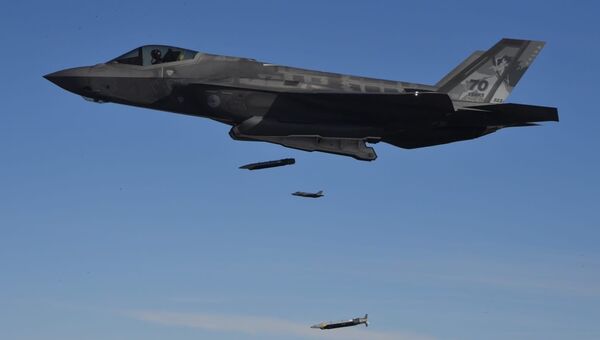Ian Knight, an F-35 pilot with the RNLAF, took to Twitter over the weekend to post images and video footage from a recent mass SDB drop test mission at the Luke Air Force Base in Maricopa County, Arizona.
Video believed to be recorded at the base’s China Lake test range showed an F-35A of the RNLAF deploying a full load of eight SDBs from its weapons bay.
Fly, my pretties, fly! #stealth #precision #F35 @Kon_Luchtmacht pic.twitter.com/zqnCtfLNua
— Ian Knight (@IanKnight35) August 22, 2020
Knight posted results from one of the two strikes, showing the range of the mass bombing, which strikes a particular area in an umbrella formation.
Always amazed at the #F35’s ability to #precision target from great distances with its outstanding sensor suite. Any day. Any weather. Any target. #makingitlookeasy #secondtonone #5thgen #allweather @Kon_Luchtmacht pic.twitter.com/vROO3oTd75
— Ian Knight (@IanKnight35) August 22, 2020
According to The Drive’s Tyler Rogoway, the glide bombs - which have been in operational use for 14 years - carry a $39,000 price tag and, depending on their launch speed and height, are capable of striking targets as far as 60 miles away.
A total of 16 SDBs were deployed during the operational test, which Knight claims was “100% successful.”
16x Precision strike = 100% successful Operational Test trial. #F35 #OT #Airpower @EdwardsAFB @Kon_Luchtmacht pic.twitter.com/HpFCMuHCu0
— Ian Knight (@IanKnight35) August 21, 2020
An August 20 news release from the F-35 Joint Program Office (JPO) noted that F-35 Lightning II Joint Strike Fighter pilots from both the US and Netherlands participated in a series of missions on August 13 and 14 geared toward enhancing interoperability and demonstrating the future performance capabilities using coalition mission data.
“We need to think differently across the F-35 Enterprise about how we provide high-quality mission data to our coalition partners so that we can optimize the common operating picture they demand, while reducing the costs associated with producing unique mission data sets for an expanding customer base,” F-35 JPO Executive Officer Lt. Gen. Eric Fick expressed in the release.
“The demonstration is paving the way for a new level of combat effectiveness and affordability in the reprogramming arena.”
The Small Diameter Bomb II, also known as the GBU-53 StormBreaker, is the next planned iteration of the glide bomb. However, according to a June report, production has been severely delayed since 2019, when “several safety deficiencies were discovered.”
"While this problem could affect all aircraft carrying the bomb, officials said the greatest impact is to the F-35, because the bomb is carried in the aircraft’s internal weapons bay and could cause serious damage if the fins deploy while the bomb is in the bay," the June report noted, referring to the fins the munition uses to glide.
Air Force spokesman Capt. Jake Bailey clarified to reporters that the clips that act “as the backup fin storage device” were found during a Raytheon audit to have “suffered vibration fatigue over long flight hours,” Defense News reported.
“The fin clip failure is the sole reason production was partially halted; once final government approval is obtained, ‘all up round’ production can resume,” he added.




